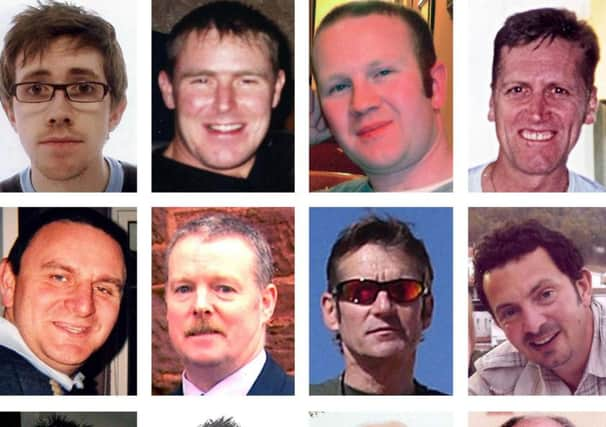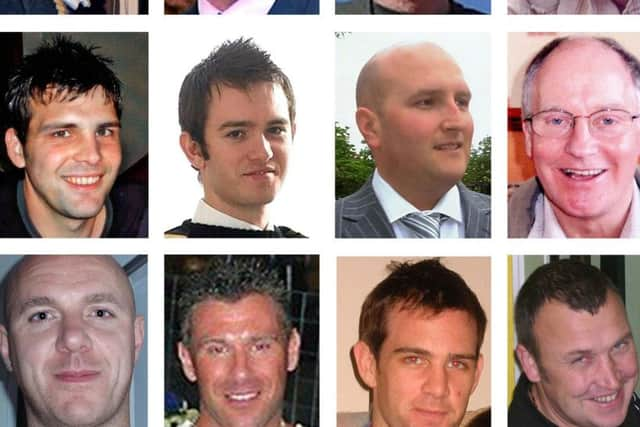Super Puma inquiry: Helicopter ‘fell like torpedo’


The statement by the sole eyewitness to the 2009 tragedy said the Bond-operated helicopter crashed without warning into the North Sea.
Relatives of the 16 men who died in the disaster broke down in tears as they listened to the evidence on the opening day of a fatal accident inquiry at Aberdeen Sheriff Court yesterday.
Advertisement
Hide AdAdvertisement
Hide AdLidvar Olav Hildre, a ship’s mechanic, was painting rails on the deck of supply vessel Normand Aurora on 1 April, 2009, when he saw the Super Puma AS332 L2 – separated from its rotor blades – plummet from 1,500ft on a flat, calm day when the sea “looked like a lake”.


In a statement read by fiscal depute Geoffrey Main, Mr Hildre recalled the “clear and sunny” day when he became aware of a helicopter passing over.
He continued: “The helicopter sounded normal as it flew above us, just the normal buzzing. Apart from the helicopter, I did not hear anything else and then suddenly there was silence.”
Mr Hildre went on: “This made me look into the air, as this was unusual, and then I saw on the starboard side of us an oblong shape falling like a torpedo towards the sea.
“The object was obviously a helicopter, but I couldn’t believe what I was seeing.


“It fell silently and I don’t think there was any smoke or anything at that point.
“Just before the helicopter hit the sea, or just as the helicopter hit the sea, I cannot be sure, I saw one flame come from the helicopter. I couldn’t say exactly where on the helicopter this came from. There was then a big splash as the helicopter hit the sea and a bang, then there was white smoke.”
Mr Hildre continued: “After this I saw, quite clearly, four large black rotor blades all attached together falling out of the sky towards the sea, separate from the helicopter. The rotor probably hit the sea around the same place as the helicopter, but I never saw it hit.”
Advertisement
Hide AdAdvertisement
Hide AdMr Hildre said he then heard a “bigger bang” as he ran to raise the alarm.
The captain of the Normand Aurora immediately launched its fast rescue craft. “I could see the debris from the crash in an area 70 to 100 metres in diameter on the surface. It was all in different sizes,” Mr Hildre said.
The bodies of eight of the oil workers were quickly recovered from the surface. They were all wearing yellow and black survival suits and lifejackets, none of which were inflated.
The bodies of the eight other men who perished in the North Sea’s second worst aircraft disaster were recovered from the seabed within the next four days.
In November 2011, a report into the disaster, published by the government’s Air Accident Investigations Branch, revealed that a catalogue of confusion, mistakes and miscommunication led to plans to replace the helicopter’s faulty gearbox being scrapped – a week before the system suffered a catastrophic failure, claiming the men’s lives.
The Bond-operated aircraft came down 12 miles off Peterhead on what should have been a routine flight from BP’s Miller field to Aberdeen.
The two crew who died were Capt Paul Burnham, 31, of Methlick, Aberdeenshire, and co-pilot Richard Menzies, 24, of Droitwich Spa, who both worked for Bond Offshore Helicopters.
KCA Deutag employees killed were Brian Barkley, 30, of Aberdeen; Vernon Elrick, 41, of Aberdeen; Leslie Taylor, 41, of Kintore, Aberdeenshire; Nairn Ferrier, 40, of Dundee; Gareth Hughes, 53, of Angus; David Rae, 63, of Dumfries; Raymond Doyle, 57, of Cumbernauld; James John Edwards, 33, of Liverpool; Nolan Goble, 34, of Norwich; and
Mihails Zuravskis, 39, of Latvia.
Advertisement
Hide AdAdvertisement
Hide AdThe other victims were James Costello, 24, of Aberdeen; Alex Dallas, 62, of Aberdeen; Warren Mitchell, 38, of Oldmeldrum, Aberdeenshire; and Stuart Wood, 27, of Aberdeen.
The fatal accident inquiry was told post mortem examinations had shown the pilots and six of the passengers – Messrs Costello, Dallas, Goble, Hughes, Rae and Taylor – were killed instantly.
The eight others died from multiple injuries caused by sudden deceleration and blunt-force trauma. The inquiry was told some of the passengers on the outward flight to the Miller platform described “hearing certain noises” during the flight.
The passengers who died in the tragedy had been described as being “in good form, laughing and joking” as they boarded the doomed Super Puma for the flight to Aberdeen heliport.
The inquiry was told the first warning of disaster came in a radio message from the helicopter, picked up by an air traffic controller, at 1:35pm.
The controller, Michael Paddon, had “heard an expletive” followed by a mayday message.
The inquiry continues.
SEE ALSO: